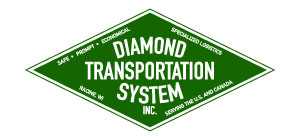Obtaining a Wide Load Permit in Florida: A Step-By-Step Guide
Hauling anything heavier and/or wider than what the state generally permits will require you to obtain a permit. And in some instances, you may need multiple permits. It can be overwhelming, but we have a step-by-step guide to help you determine what you need and how to apply for the different Florida oversize permits.
Determining What Kind of Permits You Need
You will need to look at your permit’s width, height, and length to determine if your load is within legal limits. You must obtain a permit through the Florida Department of Transportation’s Permits Office if anything exceeds the standard limits.
Width: Vehicle and load combined exceeds 102″ – or 96″ when traveling on travel lanes less than 12′ wide
Height: Vehicle and load combined exceeds 13’6″ (or 14′ for auto transporters)
Length: Single unit exceeds 40′ – or a truck with semi-trailer exceeds 41′ – or a straight truck with trailer exceeds 68′
Trip vs. Blanket Permits
There are two different types of permits that you can get – and it’s critical to know what you need so that your permit covers you thoroughly.
A trip permit will allow a move that involves one point of departure and one destination. The permit provides you/the hauler ten days to complete the trip.
A blanket permit will allow multiple trips for no more than 12 months.
The Process of Obtaining the DOT Permits
You may need a Florida wide load permit if your vehicle is too wide – and you may also need a Florida overweight permit if your load is too heavy. You may need both, depending on your situation.
If you’re unsure of what you will need or if it is likely that your load will vary between pickup points, it may be best to seek a blanket permit to ensure you’re fully covered.
Step 1: Measure the Truck
The Florida DOT will require you to include all of the truck’s dimensions, regardless of whether you are applying for an overweight or wide load permit.
There is a specific way to make the measurements – and you can use this guide.
Be sure that you get measurements all the way down to the inch. When in doubt, round up to the next inch so that you don’t end up getting in trouble with the DOT.
Consider axle spacing, front and rear overhang dimensions, and everything to include on your permit application.
Step 2: Review Route Maps
You will want to review different route maps available on the FDOT website. These will tell you about bridge restrictions and other details that will likely impact how you take a particular load.
Some wider and heavier loads cannot go on specific roads and through various underpasses. As such, you must understand the restrictions and provide a route to obtain a route-specific permit from the state.
Step 3: Fill Out the Permit Application
The permit application can be done online through the Permit Application System (PAS) or with a hard-copy application mailed or dropped off at the Florida Department of Transportation.
Within the application, you will need to provide the following information:
- Permittee info
- Blanket, trip, or route specific
- Vehicle configuration
- Identity of load
- Dimensions
- Axle information
- Routing info for trip or route-specific permits
Generally, permits take 48 to 72 hours to be approved, assuming you have filled out the application properly.
Permits Elsewhere
Remember that the permits that you obtain will only cover you throughout the state of Florida. If you are hauling beyond the state border, you must obtain permits in every state you travel to. The further you transport everything, the more time-consuming it may be to get the necessary permits.
Do your homework and talk to a professional so you don’t get penalized somewhere along your route.
Step 4: Wait for Your Permit
Your permit, once approved, will be sent to you via first-class mail. This permit must be placed inside the vehicle once you begin your travel.
Getting a copy of your trip permit on the home screen is also possible – this will allow you to print. However, the original has to be in the vehicle for DOT inspections.
What Happens if You Don’t Have the Right Permits?
As you go through the process, you may decide to skip the permits altogether. Nothing could possibly happen if you get caught without the necessary Florida DOT permits, right?
Unfortunately, ignorance doesn’t give you a pass, especially regarding the law.
Whether you go through a weigh zone or are simply pulled over, you will be asked to show the permits based on the kind of load that you are hauling. If your vehicle or load is determined to be wider than what is permitted without a valid permit, you could face serious penalties. The Florida Department of Transportation can fine you $0.05 per pound for weight over the legal weight.
Additionally, you may not be allowed to continue with transportation until you obtain a specific permit.
Get Help with a Florida Wide Load Permit
Hauling and transporting freight doesn’t have to be complicated. When dealing with wide and overweight loads, you need to obtain the right permits. However, that doesn’t mean you have to do everything on your own.
At Osage Specialized Transport, we have an array of transport services to ensure you get the help you need – from Florida DOT permits to reasonably priced transportation.
When you’re ready to get help with your load, call us to learn more. We’ll work with you every step of the way – and take care of any details you don’t want to deal with.
Reader interactions
One Reply to “Obtaining a Wide Load Permit in Florida: A Step-By-Step Guide”
Comments are closed.
















[…] Preparing oversized items for transport from one location to another is time-consuming. Experts should do it with experience working with heavy/large items and securing them on a wide-load truck. […]